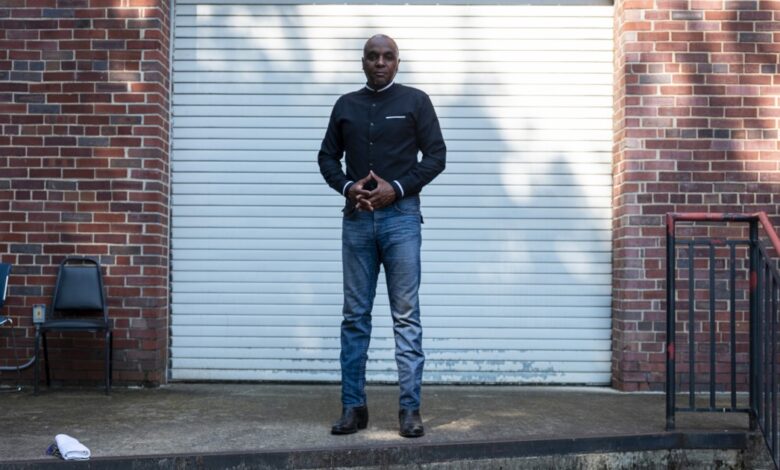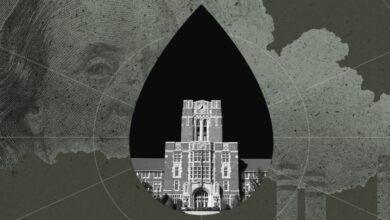The Betrayal of Historically Black Colleges

[ad_1]
He scrambled down a ladder and unlocked the doors to the administration building’s loading dock, allowing hundreds of student protesters to pour in from the cold February air in 1990.
The operation was directed by jeff obafemi carr, then a senior and president of the university’s student government. Administrators at the historically Black university had failed to meet a deadline to respond to students’ demands for modern dorms, reliable hot water, and safe lighting.
Carr’s flair for the dramatic would ensure national headlines. A theater-and-speech major, he knew just where to plant a co-conspirator, armed with provisions, before the building was locked. Students barricaded themselves inside with chains and locks. Helicopters whirred overhead, and helmeted police officers stood by, before a truce was reached and long-promised repairs began.
The students declared victory. Over the next few years, a new student center and performing-arts center went up, and buildings across the campus were renovated.
Those improvements, though, masked a far-deeper problem that is only now, 31 years later, being fully recognized. In April a joint legislative committee concluded that the university had been shortchanged by as much as half a billion dollars in state funding since 1957. As a result, the university is once again facing hundreds of millions of dollars in deferred maintenance, leaving parts of its campus crumbling.

USA Today Network; Brad Vest for The Chronicle
“I hear students talking about the same issues we complained about 31 years ago,” said carr, now a spiritual leader and community activist in Nashville, on a recent visit to campus (carr lowercases his names as a sign of humility).
At a moment when the nation’s spotlight is shining on the achievements and promise of historically Black colleges, the attention is exposing cracks in their foundations. Tennessee State and HBCUs across the country are recognizing the impact that decades of discriminatory investments have had on their campuses. State governments have, through their unequal approaches to matching federal grants, essentially padded their predominantly white land-grant institutions while starving their historically Black ones.
Now, three decades after activists at TSU first captured national attention, those longstanding inequities have been brought to light by another Tennessee State alumnus, who entered the university just as carr was about to graduate.

Brad Vest for The Chronicle
“You’ve done a good job of digging,” carr told Love. “It’s going to take continued pressure from everyone to hold the state accountable. If you don’t hold its feet to the fire, it’s out of sight, out of mind.”
They chatted with students who’d just finished moving into their dormitories, excited to be back but wishing the air conditioning worked better. When Love was a student, in the early ’90s, “there were hot days when the AC wasn’t working and cold days when the heat wasn’t working,” he said.
On the surface, the campus has greatly improved from the days when Love and carr were students. At the main entrance, white columns line a courtyard that connects two renovated, red-brick buildings, forming a welcoming campus center. A state-of-the-art Health Sciences Center opened in June, and construction is underway on a 700-bed residence hall.
But much of the campus is in disrepair. Greenhouses that were shredded in a tornado last year remain unfixed, alongside the remains of an agriculture center where livestock research was once conducted. In one academic hall, a computer-science suite lies vacant, waiting for repairs to an HVAC system whose leaking water has seeped through the floors. In another, patches of plaster curl from a ceiling damaged by leaks, and cracks spider-web across the floor.
Learotha Williams Jr., who teaches African American and public history, tells a story about a colleague who, years ago, rigged up a funnel and hose to drain a roof leak into her wastebasket. “I walked in and asked her if she was brewing moonshine,” Williams joked.
Another history professor, Erik Schmeller, recalled “cutting off the fingers of gloves to work” in a cold section of Crouch Hall, an academic building that dates to 1967. In Holland Hall, where he now works, windows don’t open and the air conditioning struggles to keep up with the sweltering heat, he said.

Brad Vest for The Chronicle
Perhaps the worst jolt to the university’s infrastructure came in the fall of 2019, when a lightning strike in Nashville damaged underground wires in the campus’s aging electrical system, leaving thousands of students without consistent electricity and hot water for months. Students circulated an online petition that demanded tuition refunds.
When roofs leak and the power goes out, Love said, it’s natural for critics to accuse university leaders of shoddy management. “No president puts off maintaining the electrical grid,” but the university “did not have the money to keep it maintained,” he said. “It was doing the best with what it had.”
The 1862 Morrill Act, which created the vast majority of land-grant institutions — one per state — set up a system in which the federal government provides grants to universities dedicated to agriculture, science, engineering, and related disciplines, as long as the amount is matched by nonfederal dollars. The matching funds usually comes from state governments, and the money must be applied to the same programs the federal grant supports. When the state doesn’t provide the matching funds, the institution often does, just to avoid losing out on the federal grants.
A second Morrill Act, in 1890, established a grant-funding program to support 19 similarly designated universities for Black students, but with a new option for grant matching. The 1890 institutions can request a waiver of half of the matching requirements. That means a state is obligated to come up with a 100-percent funding match for its predominantly white land-grant institutions, but can get away with paying its Black land-grant institutions only half the federal contribution.
In Tennessee the inequities run deeper still. Over the years, Love’s legislative committee learned, the state has always provided the predominantly white land-grant institution, the University of Tennessee at Knoxville, with a full match of the dollars it received from the federal government. Sometimes, it provided more than that. But budget documents shared with Love’s committee indicated that, from 1957 to 2007, the state had spent no matching dollars on TSU, its historically Black land-grant university.
Tennessee State’s president, Glenda Baskin Glover, said she noticed, soon after taking office, in 2013, that the matching money her university should have been receiving was absent from the state budget. She contacted Love, and together they pushed to get an accounting of how much money the campus had been shorted.
TSU had to request a waiver every year the state didn’t provide the required match, Love said, and met the 50-percent threshold with its own funds, which could otherwise have been used for scholarships, maintenance of its electrical grid, or building its endowment.
Even after the state began providing some matching funds to TSU, in 2008, it ignored a funding ratio dictated by a 1913 state law. The law (based on the ratio of Tennessee’s school-age white and Black children at the time) stipulates that the state’s predominantly white land-grant university should get about three times as much funding as its historically Black one. Most recently, the University of Tennessee, which enrolls about 31,000 students, got $69.7 million in state land-grant funds, while TSU, with about 8,000 students, received $8.7 million. That’s a funding ratio of about eight to one, despite an enrollment ratio of close to four to one.
By Love’s calculation, TSU was shortchanged $544 million in land-grant funding over six decades. Some lawmakers were incredulous at that number. The first thing some ask, he said, is, “‘Are you sure this is right?’ Then they ask, ‘How did this happen?’” The answer, Love told them, was at least in part that the state wasn’t committed to educating Black people.
A 1913 Tennessee law calls for the state’s predominantly white land-grant university to receive about three times as much money from the state as its historically Black one does.
Love’s committee directed the state’s Higher Education Commission to recommend ways to start making amends. This month, the commission issued a report recommending a series of infrastructure projects at TSU, including new dorms, a new engineering building, and campuswide improvements in the electrical system, roofs, plumbing, and lighting. Love will take that report to the legislature, hoping for an additional investment of hundreds of millions of dollars. How much the university will receive is unclear; an independent assessment last year set the price tag on the university’s most critical deferred maintenance at $337 million over five years. Love expects whatever amount the legislature approves will be spread out over 10 years.
Faculty members said they were trying to be optimistic, but they’ve grown accustomed to broken promises. “I’m glad the problem’s been acknowledged and addressed, and that they’re trying to figure out a way to rectify it,” Schmeller, the history professor, said. “But as far as a significant influx of funds, I’d be amazed if it happens this year. Maybe in five years.”
HBCUs have also encountered more obstacles to obtaining financing for capital projects, a 2018 Government Accountability Office report found. Seventy out of 79 colleges surveyed said that 46 percent of their building space needed to be repaired or replaced.
“States have grown complacent about these issues because they know there won’t be any repercussions for ignoring them,” said Adam Harris, a former Chronicle reporter who now writes for The Atlantic. His recently published book, The State Must Provide, examines the historical underpinnings of such discriminatory treatment of historically Black colleges.

Brad Vest for The Chronicle
One result of such neglect is reflected in the size of HBCU endowments. Last week the Century Foundation pointed out that, among public colleges, the average endowment per full-time student at non-HBCUs is $25,390, three and a half times as large as the figure for HBCUs, $7,265. At private colleges, it found, the disparity is more than seven to one.
In spite of those obstacles, historically Black colleges play an outsize role in providing upward mobility to at-risk students. The nation’s 101 public HBCUs make up just over 3 percent of nonprofit colleges but account for about 25 percent of Black students who graduate with STEM degrees, said David K. Sheppard, chief legal officer and chief of staff of the Thurgood Marshall College Fund, which advocates for public HBCUs. But attracting top faculty members can be tough when other campuses can pay higher salaries and offer the equipment to do cutting-edge research, he said.
Sheppard, who served as general counsel at Delaware State University from 2016 to 2018, said that for faculty members at the HBCU, “most of the physical lab research was done on the University of Delaware campus because we didn’t have the labs to do it.”
“It’s a very odd dynamic,” he said, “for you to be the primary grantee for the award and do some of the research work on another campus.”
Sheppard’s organization strongly supports passage of the Ignite HBCU Excellence Act, which was introduced in the U.S. Congress this year to provide the resources for historically Black colleges to repair, modernize, and replace their aging infrastructure.
“All we’re asking for is the same opportunity to be competitive,” Sheppard said, “for the institution and for the students.”
In Maryland, HBCUs have had some success in closing longtime funding gaps. In March, after a 15-year battle with advocates for historically Black colleges, the state agreed to provide $577 million in additional funding to the state’s four HBCUs over 10 years. A lawsuit had argued that the state had allowed predominantly white universities to create specialized academic programs that copied — and directly competed with — HBCUs, making it hard for them to recruit students.
That win has buoyed hopes that Tennessee State could get some of its missing money restored. “I’m optimistic we’re in a period where finally there’s a recognition that America has not done the right thing by HBCUs,” said David K. Wilson, president of Morgan State University, one of the HBCUs in Maryland. “It’s time to correct that. Our focus must be on ensuring that it’s not just a moment but an era.”
“I was cleaning my father’s office, looking for anything I thought would be useful, and ran across a book,” Love said. “I was shocked by the title: Special Financial Needs of Negro Universities. There was the documentation I needed to say, ‘Look, governor, this has been going on for way too long.’”
The book concluded that “TSU requires a giant leap of funding” to make up for having been deprived of matching state funds. In 1970, the elder Love had found, out of $4.5 million allocated to the state’s land-grant universities, TSU got $51,599 — about 1 percent of the total. The recommendations landed with a resounding thud in the predominantly white legislature.
As a result of such inequities, the younger Love said, generations of students have been shortchanged, along with the university itself. Take Jesse E. Russell, a 1972 electrical-engineering graduate at TSU who was instrumental in developing the cellphone while working at Bell Labs. “How many more Jesse Russells or Jessica Russells are out there who, if given the chance to attend an HBCU with adequate resources, could make even more groundbreaking discoveries?” Love asked.

Brad Vest for The Chronicle
Charlie Green Jr., a TSU senior majoring in architectural engineering and urban studies, said that if the state had always properly funded Tennessee State, “we’d have more housing and our experiences as students would be a whole lot better.”
“We take pride that some of these buildings were designed by the first Black architects in Nashville, but that was in the ’60s, ’70s, and ’80s, and a lot of the practices in building materials have changed during that time,” he said. Most dorms, Green said, don’t have kitchens or fitness centers — amenities students at many predominantly white colleges take for granted. Parking lots flood in heavy rain, and cracks in parking lots make it hard for people who use wheelchairs, he said.
Recruiting faculty, students, and staff to a campus with aging buildings and few of the amenities they’d find elsewhere has been a challenge, said Glover, the president. “Faculty look forward to working in a reasonable environment. They’re not looking for a Taj Mahal, but they don’t want to work in a building with water leaking from the ceiling.”
Williams, the history professor, said the pressure to perform amid scarce resources is intense. “They want you to work a miracle, and you shouldn’t be required to do that. There’s a different ethos that governs HBCUs,” he said. “When we take jobs, we know the facilities aren’t going to be equal. That’s a given. We know we’ll be under much more scrutiny than our sister institutions. Our successes are not going to draw as much attention, but when we stumble, it will get a lot of examination.”
As students return to Tennessee State, many suffering from the effects of the prolonged pandemic, Glover thinks about what the missing money might have covered. “Had we had the funds all along, we could have built a dynamic mental-health program for students,” she said.
Now “we’re in catch-up mode,” Glover added. “But it’s never too late to do what’s right.”
[ad_2]
Source link






